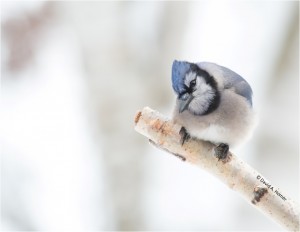So far this winter our region has been spared the near-record snowfalls and bitter cold of previous winters. It is still a challenge for us humans to get around and go about our daily business. But consider how much more difficult it can be for our feathered friends who must tough it out through the harsh and unforgiving winter.
Only those bird species who have adapted to finding sufficient food sources can manage this area’s winter conditions. These birds survive on a diet of seeds, berries, and certain kinds of insects. Cold and snow depth are key limiting factors to finding this food. For example, tall plants such as evening primrose produce seed pods containing energy-rich seeds. Many species of grasses, rushes, and sedges are also excellent seed sources. These seed carrying stalks are usually held high above the snow cover. However, in years where the snow is so deep it envelops these plants, birds are forced to search for other seed sources higher up.
Alder and birch trees produce an abundance of catkins growing on the tips of the upper branches, well above the snow line. Birds such as grouse, goldfinches, redpolls, and pine siskins devour the seeds packed into the catkins cone-like form. Berry producing shrubs such as mountain ash and winterberry are laden with fruit and attract a variety of songbirds including Bohemian waxwings. These birds are similar to their cousins, the cedar waxwings, but spend the summer breeding season in the boreal forests of northern Ontario.
Conifer trees propagate by producing cones with small, nutrient-rich seeds inside. Chickadees and goldfinches in particular visit stands of hemlock and cedar in search of this valuable seed source. We may not see the, but an abundance of insects lie hidden in trees and rock crevices waiting out the winter. These insects occur both in adult, egg, and larval stages. Chickadees can often be seen pecking at the furry, beige gypsy moth egg cases on tree trunks. Brown creepers and nuthatches scurry up and down tree limbs and trunks in search of spiders and insects hiding under the tree bark. Some of the most impressive signs of a bird’s hungry investigations are the large oval holes in dead trees created by the pileated woodpecker. These distinctive cavities are a testament to the skill and tenacity of this crow-sized bird as it searches out its primary food source, carpenter ants.
Surviving the winter is a challenge for all creatures but can be particularly difficult for birds. It is important that we protect a variety of habitats to ensure they have a choice of food sources when the cold and snow arrives. Mixed forests containing both deciduous and conifer trees, as well as open grassland areas, are crucial to their survival. The properties managed by the Couchiching Conservancy contain significant landscape types that help wildlife, especially birds, throughout the year by providing much-needed habitat. Support of our conservation efforts will help ensure these lands, and future lands we may add to our list, continue to provide this habitat.

